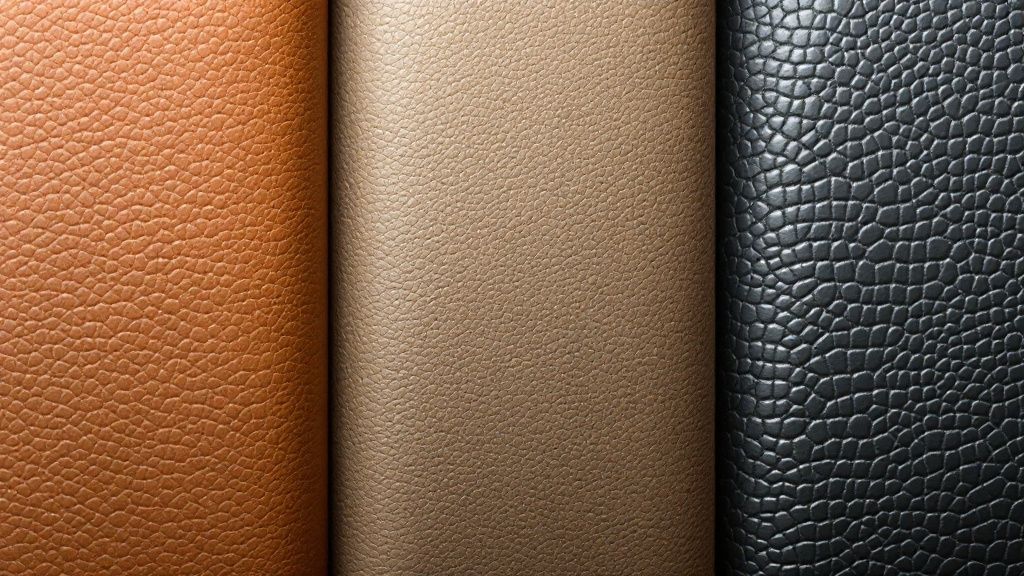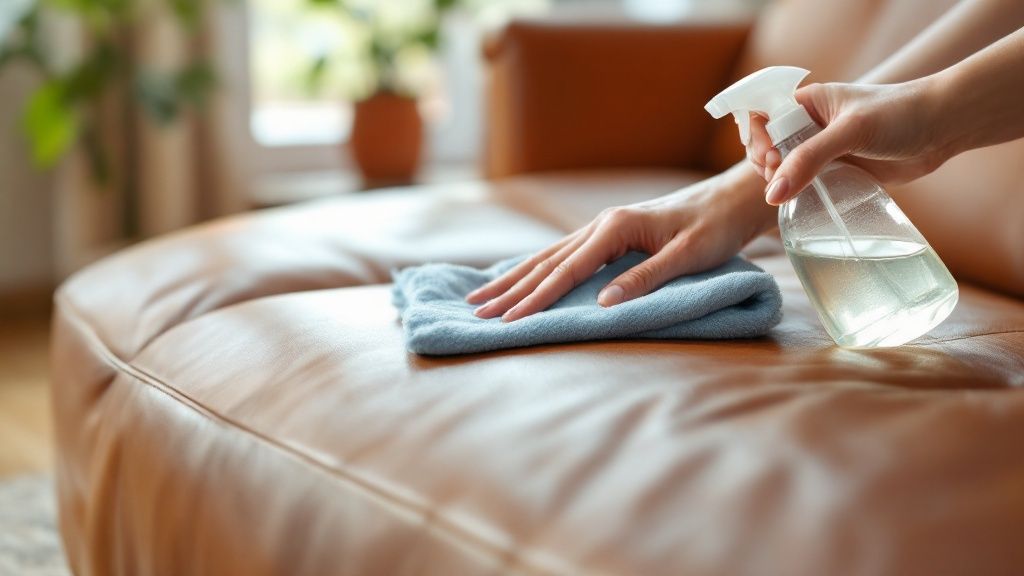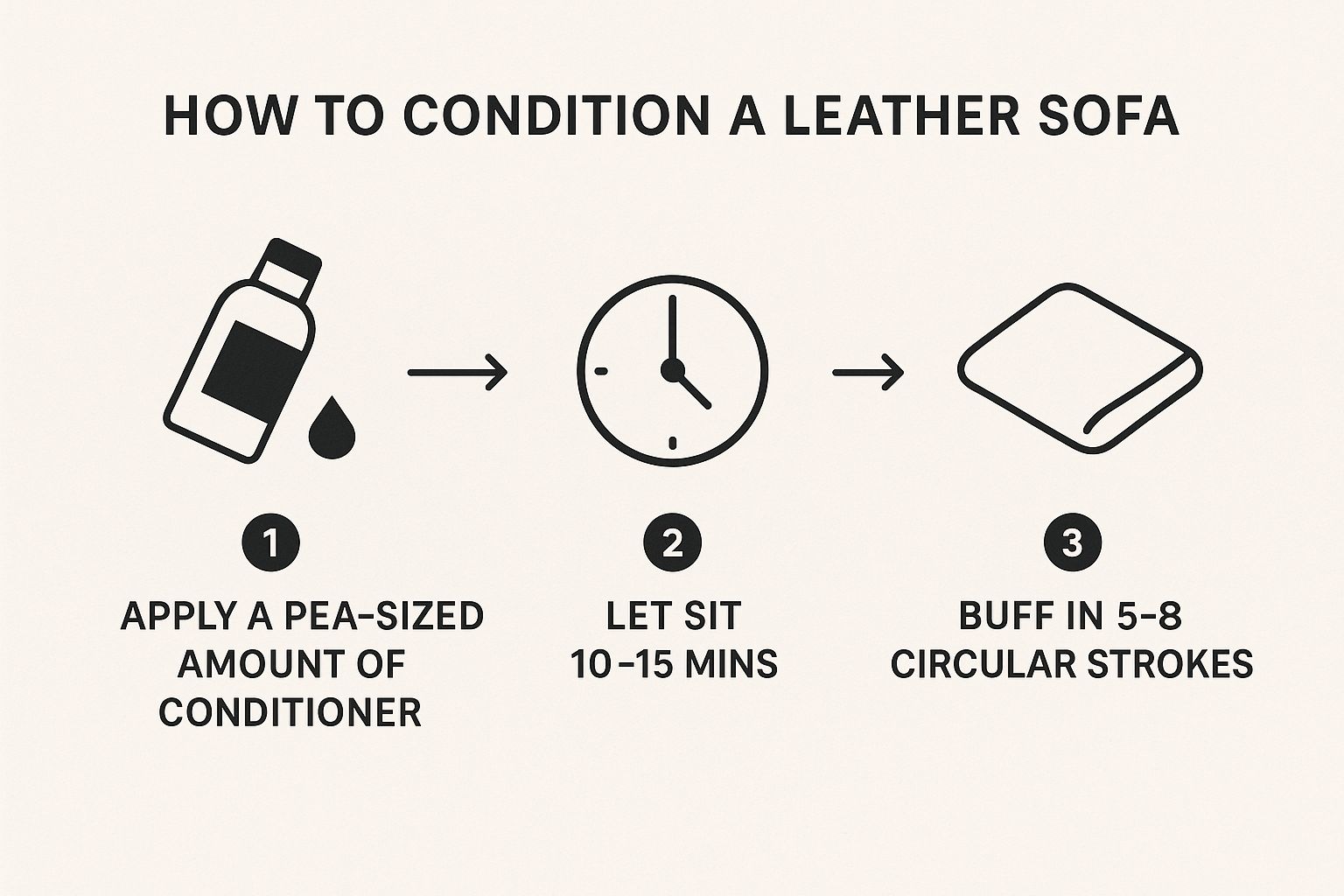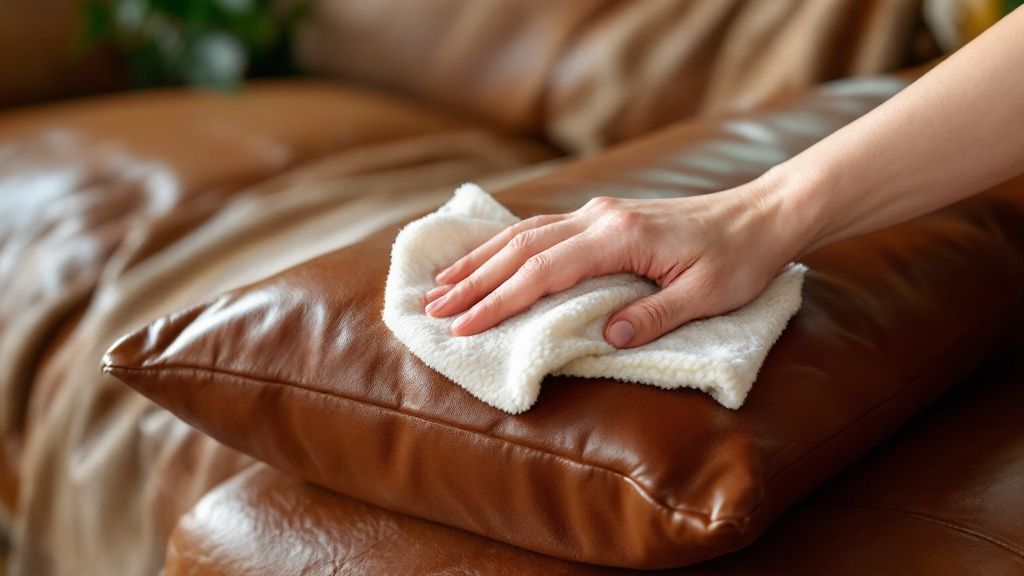The Top 10 Misconceptions About Cleaning & Caring for High End Furniture
09.30.23


That beautiful leather sofa in your living room is more than just furniture; it’s a statement piece, an investment. And like any good investment, it needs the right care to keep its value and appearance. Many people overlook the most important aspect of leather sofa care: conditioning. This simple step isn’t just about aesthetics; it’s about preserving the leather itself.
Leather is a natural material. Like our skin, it needs moisture to stay supple and strong. Over time, everyday things like sunlight, heat, and dry air can draw out the natural oils, leaving the leather dry, brittle, and vulnerable to cracking. Think of a plant that hasn’t been watered; it withers and loses its vibrancy. Similarly, unconditioned leather loses its elasticity and shows signs of wear and tear like fading, cracking, and even tearing.
Your leather sofa might not speak, but it shows telltale signs when it needs conditioning. A rough or dry texture, a loss of that signature suppleness, and even a slight color change can all be indicators. Also, watch for small cracks or creases, particularly in high-use areas like the seats and armrests. These are all signs that the leather is drying out and needs some TLC. For more tips on keeping your furniture in great shape, check out these helpful hints on how to make your furniture last longer.
More and more people are realizing how crucial leather care is, and this is reflected in the growth of the leather conditioner market. In 2024, the market was valued at about USD 100 million. Projections show it more than doubling to approximately USD 220.83 million by 2031, with a compound annual growth rate (CAGR) of 10.41%. This growth is fueled by the rising global demand for high-quality leather goods and a growing awareness of the need for proper leather maintenance. Find more detailed statistics here.
Conditioning your leather sofa isn’t just about surface appearances; it’s about preventing lasting damage. Regular conditioning replenishes the moisture, bringing back the leather’s natural flexibility and durability. This helps prevent cracking, fading, and other signs of wear, extending the life of your sofa. Without regular conditioning, even the best leather is at risk. By understanding the importance of conditioning and dedicating a little time to care for your leather sofa, you can ensure it remains a beautiful and comfortable centerpiece in your home for years to come.
Before you even consider conditioning your leather sofa, it’s crucial to identify the specific type of leather. This isn’t just about being meticulous; it’s about protecting your investment. Using the wrong product can lead to irreversible damage, transforming your beautiful sofa into a cracked and faded eyesore.
Leather comes in various forms, each with unique properties and care requirements. Knowing your sofa’s specific leather type is the cornerstone of proper conditioning.
Figuring out your sofa’s leather type is usually straightforward. The manufacturer’s tag often provides details. If the tag is missing, a few simple tests can help.
Accurately identifying your leather type prevents accidental damage from using the wrong products. For example, using a heavy oil-based conditioner on finished leather can clog the pores and create a sticky residue.
To help you better understand the different types of leather and their specific needs, take a look at the table below:
Leather Types and Their Conditioning Needs
This table compares different leather types found in sofas and the specific conditioning requirements for each.
| Leather Type | Characteristics | Conditioning Frequency | Recommended Products | Special Considerations |
|---|---|---|---|---|
| Full-Grain | Durable, natural grain, develops patina | Every 6-12 months | Leather creams, conditioners | Avoid harsh chemicals |
| Top-Grain | Smooth, uniform appearance | Every 3-6 months | Leather lotions, conditioners | Test products in an inconspicuous area |
| Genuine Leather | Less durable, more processed | Every 2-3 months | Leather conditioners, protectors | May require more frequent cleaning |
| Bonded Leather | Least durable, made from scraps | Every 1-2 months | Leather cleaners, conditioners specifically for bonded leather | Avoid excessive moisture |
As you can see, each type of leather has unique characteristics that influence its care requirements. Choosing the right products and frequency for your sofa will help maintain its appearance and extend its lifespan.
Proper leather care is essential, especially given the investment a leather sofa represents. The global leather sofa market, currently valued at USD 9.4 billion, is projected to reach USD 14.0 billion by 2033. Market.us Report on Leather Sofa Market This growth underscores the increasing consumer demand for durable and stylish furniture. Top-grain leather sofas currently hold the largest market share at 41%, highlighting the importance of effective conditioning to preserve these pieces. By correctly identifying your leather type and using the right conditioning techniques, you’ll protect your furniture investment and ensure its longevity.

Now that you know your leather type, choosing the right conditioner is the next step. The vast selection can feel overwhelming. Marketing buzzwords often mask what truly matters in a good formula. This section will help you see past the hype and discover what to look for when choosing a conditioner for your leather sofa.
Understanding the ingredients in a leather conditioner is essential. Some ingredients might seem helpful but can actually damage your leather over time.
For example, some conditioners contain waxes or silicones. These create a temporary shine but can clog the pores of the leather. This prevents the leather from breathing, which can lead to dryness and cracking.
Avoid products with harsh chemicals or petroleum distillates. These can strip the leather of its natural oils, leading to faster deterioration. Instead, choose conditioners with natural oils and moisturizers like lanolin, neatsfoot oil, or jojoba oil. These ingredients nourish the leather without clogging the pores, promoting long-term health and suppleness.
There’s an ongoing debate about natural versus synthetic conditioners. Some people believe natural ingredients are always better. Others prefer the reliability of synthetic formulas. The real key isn’t whether the ingredients are natural or synthetic, but how effective and compatible they are with your specific leather type.
Some eco-friendly products perform very well, while others fall short. As discussed in a blog post on Style By Emily Henderson, testing various products reveals noticeable differences. One product, Leather Honey, was difficult to apply and darkened the leather. Lexol provided a smoother application and a more appealing result. This demonstrates the importance of experimentation.
Choosing the right conditioner means finding the product that suits your sofa’s particular needs. Full-grain leather, being more porous, benefits from richer creams that penetrate deeply. Top-grain leather often does well with lighter lotions. Genuine leather, being more processed, might require conditioners with extra protection against staining and fading. Bonded leather needs specialized conditioners designed for its unique construction.
The Kwendy Home blog highlights the importance of using a simple leather conditioner yearly to prevent cracking, especially in areas with fluctuating climates. They advise testing any new formula in an inconspicuous area first, underscoring the importance of knowing your leather’s specific requirements.
Before applying any conditioner to your entire sofa, test it on a hidden area like the underside of a cushion. This lets you see how the leather reacts to the conditioner, ensuring compatibility and avoiding any unwanted surprises. This precautionary step, commonly used by professionals, can prevent costly errors.
By carefully considering the ingredients, understanding the differences between natural and synthetic options, and matching the conditioner to your leather type, you can find a product that genuinely nourishes and protects your leather sofa. Always remember to test in a hidden spot before applying it to the entire piece, ensuring a successful and satisfying conditioning process.
Transforming a dry, neglected leather sofa into a supple showpiece requires a more nuanced approach than simply applying conditioner. Professional furniture restorers understand the importance of a methodical process, from preparation to precise application. This section reveals the secrets to conditioning your leather sofa like a pro.
Meticulous preparation is crucial before applying any conditioner. This often-overlooked step ensures maximum absorption and effectiveness. Begin by thoroughly cleaning the sofa to remove dust, dirt, and grime, which can hinder the conditioner’s penetration. Use a soft, damp cloth and a pH-neutral leather cleaner. Avoid harsh chemicals that can strip the leather’s natural oils. This cleaning primes the leather for optimal conditioner absorption.
The method of conditioner application significantly impacts its efficacy. Professionals use specific techniques for even distribution and optimal absorption. The following infographic illustrates the process:

The infographic emphasizes using a pea-sized amount of conditioner, allowing it to penetrate the leather for 10-15 minutes, and then buffing with 5-8 circular strokes for even distribution and a polished finish. This prevents product waste and ensures full absorption.
Leather conditioning, like a fine wine, is influenced by time and temperature. Professionals understand that warmer temperatures enhance absorption. Conditioning in a cold room can hinder the process, leading to uneven application and reduced effectiveness. The recommended dwell time of 10-15 minutes maximizes penetration. Rushing this step can compromise the results.
Seams and high-wear areas, such as armrests and seats, require extra care. These areas tend to dry out and show wear more quickly. Apply a slightly thicker layer of conditioner to these vulnerable spots, gently massaging it into the seams with a soft-bristled brush. This targeted approach prevents cracking and preserves the leather.
Even experienced leather sofa owners can make mistakes. Over-conditioning can clog the leather’s pores, creating a sticky residue. Using the wrong type of conditioner is another common error. For instance, using a thick conditioner on soft leather can lead to uneven darkening, as highlighted in a review on Style By Emily Henderson. Neglecting to buff after conditioning can leave the leather greasy and attract dust.
To help you avoid these common mistakes, and keep your leather in top condition, the following table outlines the steps and troubleshooting advice:
This table outlines the step-by-step process of conditioning leather sofas and solutions to common problems that might arise.
| Step | Instructions | Common Mistakes | Troubleshooting Tips |
|---|---|---|---|
| Cleaning | Use a soft, damp cloth and pH-neutral cleaner. | Using harsh chemicals or abrasive cleaners. | Test the cleaner in an inconspicuous area first. |
| Conditioning | Apply a pea-sized amount and buff in circular motions. | Over-conditioning or using the wrong type of conditioner. | Allow the conditioner to penetrate fully before buffing. If the leather feels sticky, wipe with a clean, damp cloth. |
| Targeting Trouble Zones | Apply a slightly thicker layer to seams and high-wear areas. | Neglecting these areas or applying too much conditioner. | Gently massage the conditioner into seams with a soft brush. |
| Drying | Allow the sofa to air dry for 24-48 hours. | Placing the sofa in direct sunlight or near heat. | Ensure the room is well-ventilated. |
By following these steps and avoiding common mistakes, you can ensure your leather sofa stays in excellent condition.
After conditioning, allow the sofa to air dry completely for 24-48 hours. This allows the leather to fully absorb the conditioner. Avoid direct sunlight and heat sources, which can damage the leather. Regular dusting and vacuuming with a soft brush attachment maintain the conditioned state and prevent dirt buildup. By following these professional techniques, you can extend the lifespan of your leather sofa and maximize your investment, as emphasized by High End Used Furniture.

Proper leather sofa care isn’t about sticking to a strict timetable. It’s about understanding your sofa’s individual needs and establishing a personalized conditioning calendar. Much like how different plants thrive with varying watering schedules, your leather sofa requires specific care depending on various factors. This customized approach will keep your sofa looking its best for many years.
Several factors dictate how frequently you should condition your leather sofa.
Spotting the early signs of dryness can prevent more serious damage down the road. These subtle hints suggest your sofa needs some attention.
Addressing these signs promptly with conditioning can prevent cracking and tearing.
Similar to adjusting skincare routines with changing seasons, your sofa care should adapt too. Dry winter air often necessitates more frequent conditioning than humid summer months. Consider conditioning every three months during winter and every six months during summer, adjusting as needed.
Over time, you’ll develop a feel for your sofa’s needs. Regularly examining the leather will give you a good sense of its condition. This allows you to adapt your conditioning schedule accordingly, ensuring optimal care. Building this personalized calendar ensures your leather sofa receives the proper care at the right time, preserving its beauty and extending its lifespan. Explore our collection of high-end used furniture for pieces that complement your meticulously cared-for sofa.
Conditioning is essential for leather sofa care, but it’s just one part of the equation. For true protection and lasting beauty, you need a comprehensive system. This means understanding what causes wear and tear and taking steps to minimize it.
Leather, much like our skin, is vulnerable to environmental damage. Sunlight, humidity, and even common household items can gradually degrade its quality.
Spills happen, but quick action can prevent stains. Blot spills immediately with a clean, dry cloth. Don’t rub, as this can spread the stain. For stubborn stains, consult a professional leather cleaner.
Regular conditioning and cleaning are usually sufficient, but some problems need expert care. Deep scratches, large tears, or widespread discoloration are best left to professional leather repair specialists. Their skills can restore your sofa and prevent further issues.
Think of leather sofa care like tending a prized plant. It flourishes with regular attention and the right environment. Combine regular conditioning with protection from sunlight, humidity, and household hazards for a well-rounded care system. This approach extends your sofa’s life and preserves its beauty. Knowing when to seek professional help is also important. Just as a gardener knows when to prune or fertilize, you’ll learn to recognize your sofa’s unique needs. This complete protection system ensures your leather sofa remains a cherished piece for years to come.
Looking to enhance your living space? Explore our collection of high-quality pre-owned furniture at High End Used Furniture and find the perfect complement to your beautifully conditioned leather sofa.
High end used furniture